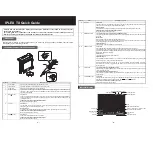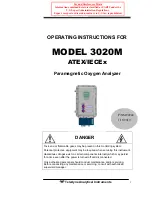
Standards for Trace Level Analyzers
Geysitech Commands
E-2
Model 42
i
Trace Level Instruction Manual
Thermo Fisher Scientific
Thermo Fisher Scientific believes it is not necessary to generate
concentrations below these levels since the fundamental linearity of the
instrumentation has been demonstrated.
If however, the zero air used for dilution and for establishing baseline
conditions has impurity levels greater than several tenths of a ppb, the
accuracy of the analyzer being calibrated may be severely jeopardized. A 0.5
ppb impurity level is equivalent to a 10% relative error for a 5 ppb
concentration.
Ultra-zero ambient monitoring gases are available from gas suppliers,
however, the typical analyses for No
x
and SO
2
impurities only guarantee
levels below 5 ppb. In practice, Thermo Fisher Scientific’s personnel as well
as other users of Trace Level equipment have found these gases to be at
least an order of magnitude better than what is guaranteed, and therefore
are adequate for most purposes. Non-reactive and diffusion resistant
regulators are required, and as the cylinder pressure falls below 500 psig,
the integrity of the zero gas becomes more in question.
Rather than relying on cylinder sources for zero air, Thermo Fisher
Scientific routinely uses zero air generate by “brute force”, that is, by
compression, chemical scrubbing and reaction. Ambient air that has been
compressed and pressurized to give an output of about 25 psig is dried by
passing the air through a heatless air dryer (for example) and then sent
through a series of chemical reactors and/or scrubbers. Normally, these
include indicating silica gel, Purafil, activated charcoal, and a fine (5
micron) particulate filter. When first used, this “brute force” approach
actually can generate enhanced impurity levels for No
x
and SO
2
, as these
gases desorb from the chemical reactors. However, after 24 to 48 hours of
continuous operation, impurity levels will generally fall and stabilize below
detection limits for the Trace Level analyzers. It is critical when using this
type of zero air source to always maintain flow through the system. If flow
is interrupted, even for a short period, a reconditioning time of up to 24
hours may be required.
The Model 42
i
Trace Level analyzer has zero air diagnostic capability built
within the instrument. The monitor has three channels, a NO, No
x
, and
prereactor channel. The prereactor channel mixes the sample with a high
concentration of ozone prior to the detection chamber. This effectively
creates a dynamic zero by removing any NO from the gas stream. If the
zero air source being used is truly a good zero air, the background signals in
the NO, No
x
, and prereactor modes are virtually identical (within 0.1 to
0.2 ppb due to pneumatic differences). If the background in the no and/or
No
x
channels are enhanced relative to the prereactor channel, the zero air
source being used is inadequate. When calibrating the zero in the Model
42
i
Trace Level, the background levels are calculated and available in the
Calibration Factors menu. Normal background levels are in the 0.5 to 1.5



































